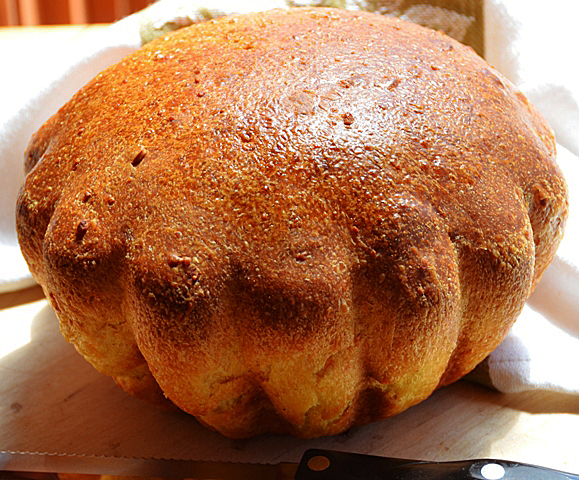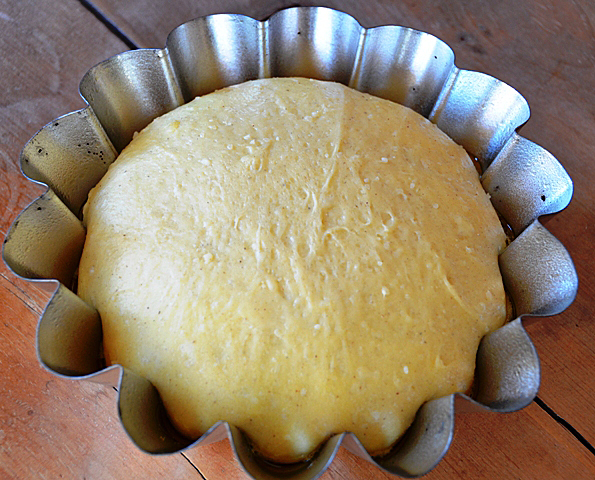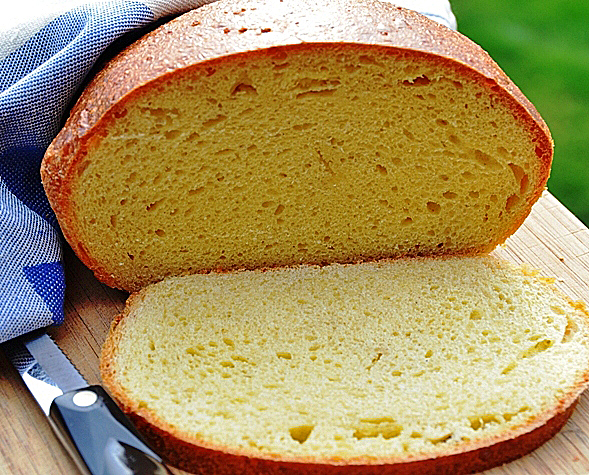
A good soup deserves a good bread and so it was with the Italian Wedding Soup. Staying with the Italian theme I found a recipe for Italian Easter Cheese Bread. Crescia al Formaggio, is a crusty bread that is fragrantly cheesy but dry in texture. The bread originates from Umbria in the central part of Italy where it is often baked in outdoor stone ovens as part of the Easter Sunday lunch. It is a golden brioche-like dough enriched with eggs. If you want to be authentic it should be baked in a terra cotta pot, previously unused of course, with the drainage hole plugged up. I chose the also traditional pandoro or star pan, but any deep round pan will do . “Crescia” refers to the way the dough domes or crests over the pan it is baked in. Leftover bread (if there is any) would make excellent grilled cheese sandwiches or even croutons. I plan on making it again in the summer for tomato sandwiches.

Italian Easter Cheese Bread
from the King Arthur Flour Website
Dough:
- 2 1/2 cups unbleached all purpose flour
- 1 1/4 t instant yeast (SAF is my favorite)
- 3 large eggs at room temperature
- 1 large egg, separated, reserve the white for the glaze
- 1/4 or more lukewarm water
- 1/4 cup (4 tablespoons) softened unsalted butter
- 1 t salt
- 1t freshly ground pepper
- 1 1/4 cups freshly grated cheese, Parmesan, Romano, Asiago, use one, two or a combination of all three
Glaze:
- reserved egg white (from above)
- 2t cold water
Directions:
- Combine all ingredients except cheese in the bowl of an electric stand mixer, beat on medium speed for 10 minutes, until the dough becomes satiny and shiny. This dough is very sticky so you will need to stop the mixer to scrape the sides and bottom of the bowl several times during the mixing process.
- Add the cheese, beat until well incorporated.
- Scrape the dough into a lightly greased bowl, cover the bowl, and set it aside to rise for 1 hour; it doesn’t rise much. Gently deflate the dough, turn it over, return it to the bowl and allow it to rise for another hour, again it does not rise very much.
- Oil your hands. To make the traditional round loaf, form the dough into a ball, and place it in a greased deep round pan like a souffle dish, panettone pan or the pandoro pan. The dough could also be braided and baked in a 9 x 5 loaf pan.
- Cover the bread lightly, plastic wrap or a clean cloth dishtowel is what I choose. Allow the loaf to rise for at least 2 hours or longer. The dough should be noticeably puffy, but not doubled in size.
- To bake the bread: Put your oven rack in it’s lowest position and preheat oven to 425°F
- Whisk reserved egg white with the water and brush the top of the loaf.
- Place the bread in the oven and bake for 15 minutes.
- Reduce the temperature to 350°F, tent with aluminum foil and bake for an additional 30-35 minutes until it is a deep golden brown and an instant read thermometer registers 190°F. The braided loaf will take less time.
- Remove the bread from the oven, let cool in the pan for 5 minutes. Then turn the loaf onto a cooling rack to cool completely before slicing.
- Store airtight at room temperature for several days. Freeze tightly wrapped for longer storage.
Makes one loaf
My personal notes: I made this bread on a day with very low humidity and I found I needed more water than the original recipe called for to achieve the sticky consistency. I also did the second rise overnight in the refrigerator before forming the bread and that worked fine.
